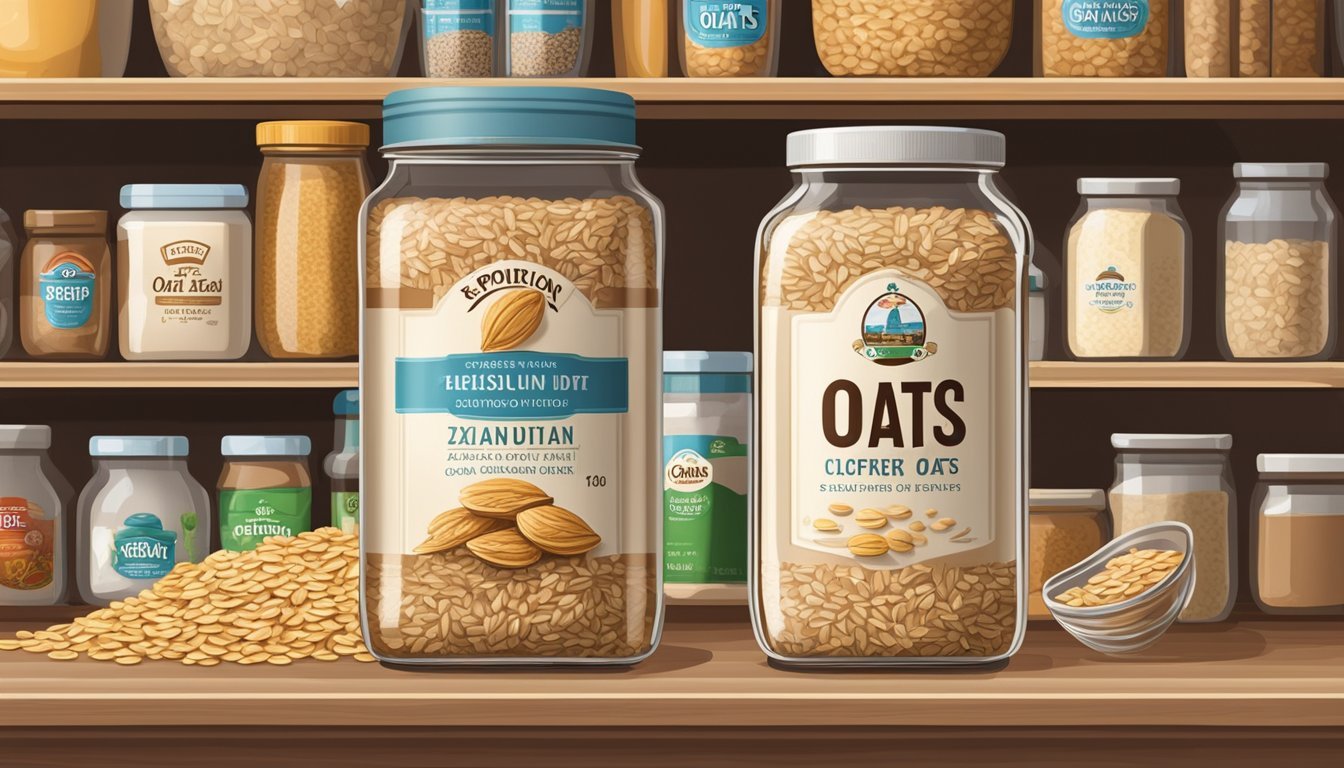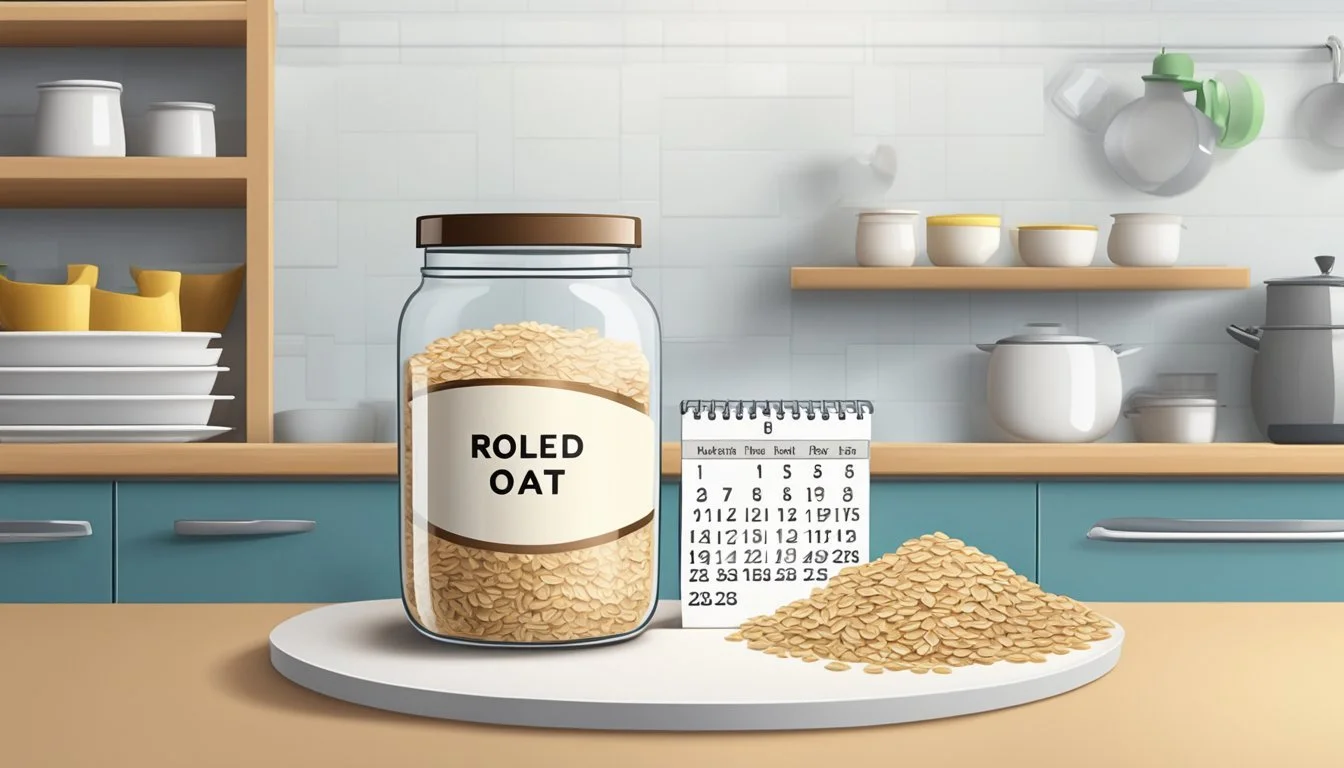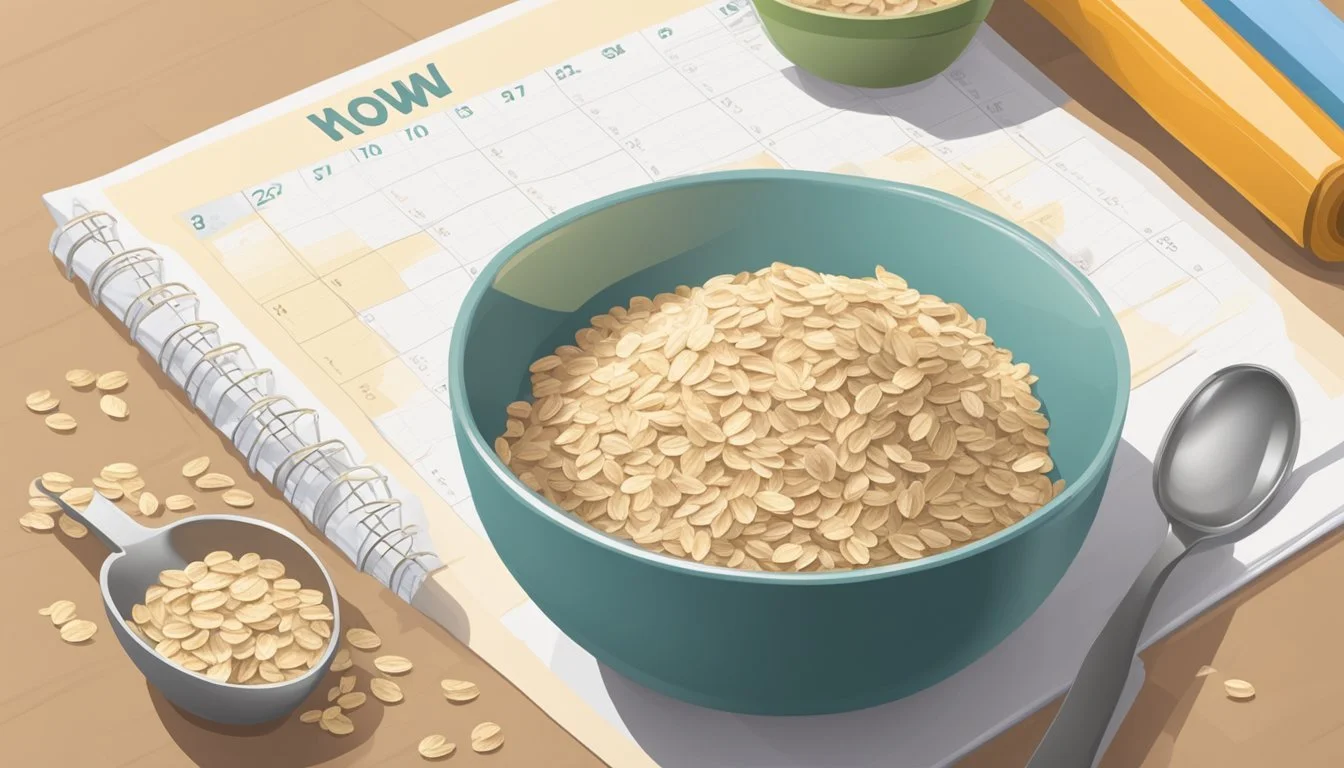How Long Do Rolled Oats Last?
Shelf Life and Storage Tips
Rolled oats are a staple in many pantries due to their versatility and health benefits. They are commonly consumed in the form of oatmeal but are also integrated into baked goods and other dishes. With their high fiber content and numerous essential nutrients, rolled oats offer a convenient and nutritious option for any meal of the day. However, the longevity of rolled oats' freshness is contingent on various storage conditions and whether the packaging has been opened.
Unopened rolled oats, when stored correctly in a cool, dry place, can generally last from one year to two years, maintaining their quality and edibility. Once opened, the shelf life decreases, and the oats may last approximately six to nine months. Proper storage is key after opening, as transferring the oats to an airtight container can help preserve their freshness and extend their usability.
Consumers need to recognize that while oats are shelf-stable, they are not immune to spoilage. Factors that contribute to this include exposure to moisture, air, and pests, which can all affect the oats' quality and safety. Therefore, employing correct storage methods not only retains the nutritional value of the oats but also ensures they remain a safe and enjoyable food item.
Understanding Oats
Oats are a whole-grain food known for their nutritional value and health benefits. They come in various forms and offer a rich source of fiber, vitamins, and minerals.
Different Types of Oats
Rolled Oats: These are whole oats that are steamed and flattened. They have a moderate cooking time and a creamy texture.
Steel-Cut Oats (how long do steel-cut oats last?): Produced by chopping whole oat groats (how long do oat groats last?) into pieces. They have a chewy texture and take longer to cook.
Instant Oats: These oats are pre-cooked, dried, and then rolled. They cook very quickly and have a softer texture.
Oat Groats: The whole oat kernel with only the hull removed. Groats take the longest to cook.
Nutritional Value
Oats are rich in complex carbohydrates and fiber, specifically a soluble fiber called beta-glucan. They also contain important vitamins and minerals like B vitamins, iron, and magnesium. Rolled oats provide a balance between nutrient density and convenience, making them a preferred choice for many.
Nutrient Benefit Fiber Aids digestion and satiety B Vitamins Supports energy production Iron Crucial for blood formation Magnesium Essential for numerous biochemical reactions
Health Benefits
Regular consumption of oats can lead to several health benefits:
Cholesterol Levels: The beta-glucan in oats helps reduce LDL cholesterol, promoting heart health.
Heart Health: Oats are associated with a lower risk of heart disease, partly due to their content of antioxidants and omega-3 fatty acids.
Essential Nutrients: Daily oat intake ensures a supply of essential nutrients that support overall health.
The antioxidants present in oats, along with these essential nutrients, contribute significantly to their health-boosting properties.
Shelf Life Fundamentals
The shelf life of rolled oats typically spans from 18 months to 30 years depending upon storage conditions, with unopened packages lasting the longest.
Factors Affecting Oat Shelf Life
Storage Environment: To maximize shelf life, oats should be stored in a cool, dry area away from direct sunlight. Moisture is particularly detrimental, as it can lead to mold growth and oxidation of fats, compromising quality and safety.
Packaging: Oats last longer when stored in an airtight container that prevents exposure to air and moisture. Packaging options include:
Mylar bags with oxygen absorbers
Airtight glass containers
Original unopened packaging
Temperature: A consistent, low temperature helps preserve the freshness and flavor of oats, while high temperatures can accelerate spoilage.
Humidity: High humidity environments can cause oats to absorb moisture, leading to a stale texture and potential mold growth.
Common Signs of Spoilage
When assessing if rolled oats have gone bad, consider the following indicators:
Smell: A noticeable off or sour odor is a clear sign that oats have spoiled.
Mold: Visible mold or discoloration within the oats indicates spoilage.
Texture: Oats that feel slimy or unusually moist have likely been compromised by moisture.
Color: Any significant change in the color of the oats may suggest spoilage.
Flavor: If the oats taste stale or have an off flavor, they are no longer fresh and should not be consumed.
By understanding these fundamental aspects, consumers can ensure their rolled oats maintain the highest level of quality and safety throughout their shelf life.
Proper Storage Solutions
Effective storage solutions are essential to maintaining the freshness and extended shelf life of rolled oats. This section explores best practices for oat storage, the most suitable containers and conditions, and special considerations specifically for rolled oats.
Best Practices for Oat Storage
To ensure maximum shelf life for rolled oats, they should be stored in a cool, dry place away from direct sunlight and any sources of heat. This could typically be a pantry, cupboard, or any storage area that fulfills these conditions. It is crucial to keep oats at a consistent temperature to prevent any deterioration in quality.
Containers and Conditions
Choosing the right storage container is central to preserving the quality of rolled oats. Containers should be airtight to prevent moisture and pests, which can spoil the oats. Ideal containers may include:
Glass jars with tight-sealing lids
Stainless steel containers with airtight lids
Ceramic canisters with gasket seals
Mylar bags with oxygen absorbers
Use oxygen absorbers in the containers to extend the shelf life by preventing oxidation. For long-term storage, consider the following:
Storage Duration Recommended Container Short-term Airtight glass or plastic containers Long-term (up to 30 years) Mylar bags with oxygen absorbers
Special Considerations for Rolled Oats
While rolled oats may last a considerable time, they are nonetheless susceptible to spoilage if not stored correctly. A key consideration is to avoid any contact with moisture or pests which could lead to the presence of mold or insects. If storing oats in a freezer to further extend shelf life, ensure they are sealed in a moisture-proof, air-tight container to avoid freezer burn. Remember that rolling oats increases their surface area and can make them more vulnerable to environmental factors, so stringent storage measures are advisable.
Maximizing Oat Longevity
The shelf life and quality of oats can be significantly affected by storage conditions. Employing proper storage methods can maintain their high fiber content and prevent deterioration.
Extending Shelf Life of Oats
Temperature: Storing oats in a cool, dry place is essential. High temperatures can accelerate the degradation process, reducing the oats' quality over time.
Containers: Transfer oats to airtight containers after opening to protect them from moisture and pests. This practice is crucial, especially for bulk purchases.
For uncooked oats, such as rolled, quick, or steel-cut, sealed containers are ideal to preserve freshness and extend the shelf life beyond their best by date.
Pantry vs. Freezer: While a pantry is adequate for short-term storage, placing oats in the freezer can extend their shelf life up to 24 months, reducing the risk of freezer burn in comparison to other foods.
Do's and Don'ts
Do:
Check the expiration date or best before on packaged oats to estimate their shelf life.
Opt for commercially processed oats for longer storage, as these usually undergo treatments that inhibit spoilage.
Don't:
Use oats that exhibit any signs of spoilage, such as a stale smell or presence of pests, regardless of the best by date.
Assume that all oats are the same; instant oats may not last as long as other types due to added ingredients.
Using Oats in Cooking
When incorporating oats into culinary creations, understanding the attributes of different types can elevate the quality of the dish, particularly in terms of texture and nutritional value.
Oats as an Ingredient
Rolled oats, also known as old-fashioned oats, are a versatile ingredient. They are whole oat groats that have been steamed and flattened. This process extends their shelf life and shortens cooking time while maintaining a high fiber content. They are commonly used in baked goods like cookies and cakes, imparting a chewy texture.
Instant oats or quick oats (how long do quick oats last?) are further processed, providing a convenient and faster cooking time ideal for busy mornings. They’re suitable for quick breakfast foods like porridge or instant oatmeal.
Steel-cut oats, also called Irish or Scotch oats, are less processed than rolled or instant varieties and have a nuttier flavor and a firm texture. They are superb in making a hearty, traditional oatmeal breakfast that pairs well with milk, fruits, or other sweet or savory toppings.
When using oats in cooking, chefs might substitute some flour with ground oats to add nutritional value or create a desired texture in dishes such as pasta.
Storage After Cooking
Cooked oatmeal, whether it’s made from rolled, instant, or steel-cut oats, should be stored properly to maintain freshness and prevent spoilage.
Cooked oatmeal: Store in an airtight container and refrigerate for up to 5 days.
Prepared oatmeal can also be frozen. Portion into a freezer-safe container and freeze for up to 3 months for best quality.
Proper storage of cooked oats can make it a convenient starting point for various recipes, allowing for quick, nutritious meals throughout the week.
Dealing with Contaminated Oats
When handling rolled oats, one must prioritize food safety to prevent health issues. Contamination can affect the shelf life and quality of oats, leading to potential foodborne illnesses.
Identifying and Preventing Contamination
Contamination in rolled oats can stem from various sources, such as moisture, pests, or the presence of mold and bacteria. Key indicators include:
Mold Growth: Visible mold or a musty smell indicates spoilage.
Pests and Bugs: Signs of insects or rodent droppings suggest contamination.
Off-Putting Smells: Stale or rancid odors point to degradation of the oats' natural oils.
Preventative measures include:
Storing oats in a cool, dry place to prevent moisture accumulation.
Utilizing airtight containers to shield oats from pests and environmental contaminants.
Regularly inspecting packaging for damages that could allow contaminants to enter.
Health Implications
Contaminated oats can harbor foodborne bacteria leading to health risks if consumed. Eating rancid oats, those with mold growth, or contaminated by pests can cause digestive issues and food poisoning. To ensure food safety, one should:
Discard any oats that show signs of contamination.
Practice good hygiene and cleanliness in storage spaces.
Oats that have an unusual appearance or smell should not be consumed.
Repurposing Stale or Spoiled Oats
Even after rolled oats lose their desirable texture or flavor beyond their expiration date, they can still serve a variety of non-edible purposes. Instead of discarding stale or spoiled oats, consider these resourceful alternatives for household use.
Non-Edible Uses for Oatmeal
Household Deodorizer: Stale oats can absorb odors. Place a bowl of stale rolled oats in a fridge or any space that requires freshness to neutralize unpleasant scents.
Natural Cleaners:
Abrasives: Mix rolled oats with water to create a natural abrasive for cleaning surfaces.
Dry Shampoo: Ground stale oats can act as a dry shampoo, effectively absorbing excess oil from hair.
Pet Care: Rolled oats possess soothing properties that may benefit pets' skin. Utilize them in baths or as bedding for small animals to provide gentle relief.
Craft Materials: Due to their texture, spoiled oats can be used in various crafts, such as making textured paper or for filling in homemade heating pads and plush toys.
Skin Care Scrubs: Stale rolled oats can be ground and used as a base for homemade body scrubs. Mixed with other perishable ingredients, such as honey or yogurt, they exfoliate the skin gently.
Composting and Recycling
Compost Addition: Expired rolled oats enrich compost piles by providing carbon-rich material, which encourages compost aeration and supports beneficial microorganisms.
Plant Nutrition:
Soil Amendment: Spoiled oats can be directly mixed into garden soil as an organic amendment, aiding in moisture retention and nutrient supply.
Liquid Fertilizer: Fermenting stale oats in water can produce a nutrient-rich liquid that serves as an excellent fertilizer for plants.
In essence, stale or spoiled rolled oats don't have to go to waste; they can be effectively repurposed in many resourceful and environmentally friendly ways.









